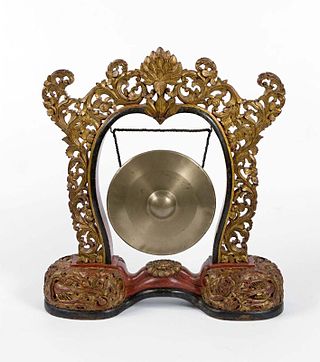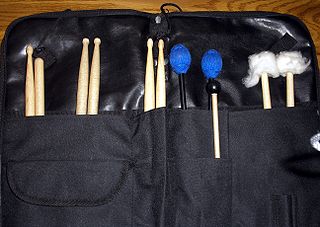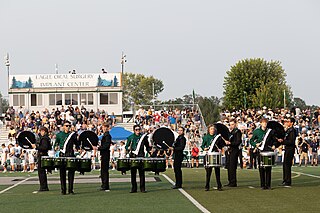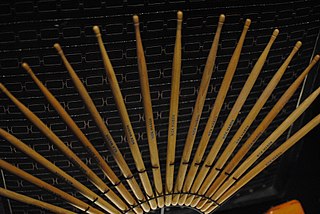
A cymbal is a common percussion instrument. Often used in pairs, cymbals consist of thin, normally round plates of various alloys. The majority of cymbals are of indefinite pitch, although small disc-shaped cymbals based on ancient designs sound a definite note. Cymbals are used in many ensembles ranging from the orchestra, percussion ensembles, jazz bands, heavy metal bands, and marching groups. Drum kits usually incorporate at least a crash, ride, or crash/ride, and a pair of hi-hat cymbals. A player of cymbals is known as a cymbalist.

A drum kit is a collection of drums, cymbals, and sometimes other auxiliary percussion instruments set up to be played by one person. The drummer typically holds a pair of matching drumsticks, and uses their feet to operate hi-hat and bass drum pedals.

A percussion instrument is a musical instrument that is sounded by being struck or scraped by a beater including attached or enclosed beaters or rattles struck, scraped or rubbed by hand or struck against another similar instrument. Excluding zoomusicological instruments and the human voice, the percussion family is believed to include the oldest musical instruments. In spite of being a very common term to designate instruments, and to relate them to their players, the percussionists, percussion is not a systematic classificatory category of instruments, as described by the scientific field of organology. It is shown below that percussion instruments may belong to the organological classes of idiophone, membranophone, aerophone and chordophone.

The bass drum is a large drum that produces a note of low definite or indefinite pitch. The instrument is typically cylindrical, with the drum's diameter much greater than the drum's depth, with a struck head at both ends of the cylinder. The heads may be made of calfskin or plastic and there is normally a means of adjusting the tension either by threaded taps or by strings. Bass drums are built in a variety of sizes, but size does not dictate the volume produced by the drum. The pitch and the sound can vary much with different sizes, but the size is also chosen based on convenience and aesthetics. Bass drums are percussion instruments and vary in size and are used in several musical genres. Three major types of bass drums can be distinguished.

A gong is a percussion instrument originating in East Asia and Southeast Asia. Gongs are a flat, circular metal disc that is typically struck with a mallet. They can be small or large in size, and tuned or can require tuning.

A percussion mallet or beater is an object used to strike or beat a percussion instrument in order to produce its sound.

Clash cymbals are cymbals played in matched pairs by holding one cymbal in each hand and striking the two together.

A suspended cymbal is any single cymbal played with a stick or beater rather than struck against another cymbal. Common abbreviations used are "sus. cym.," or "sus. cymb.".

Marching percussion instruments are percussion instruments specially designed to be played while moving. This is achieved by attaching the drum(s) to a special harness worn by the drummer, although not all marching bands use such harnesses and instead use traditional baldrics to sling their drums.

Ionisation (1929–1931) is a musical composition by Edgard Varèse written for thirteen percussionists. It was among the first concert hall compositions for percussion ensemble alone, although Alexander Tcherepnin had composed an entire movement for percussion alone in his Symphony No. 1 from 1927. In the journal Tempo, percussionist Brian Holder writes, "The work presented the important notion that unpitched percussion could stand alone as a serious form of concert music – a relatively unexplored concept at the time."

The term Chinese orchestra is most commonly used to refer to the modern Chinese orchestra that is found in China and various overseas Chinese communities. This modern Chinese orchestra first developed out of Jiangnan sizhu ensemble in the 1920s into a form that is based on the structure and principles of a Western symphony orchestra but using Chinese instruments. The orchestra is divided into four sections – wind, plucked strings, bowed strings, and percussion, and usually performs modernized traditional music called guoyue. The orchestra may be referred to as Minzu Yuetuan or Minyuetuan in mainland China, Chung Ngok Tuen in Hong Kong, Huayuetuan in Southeast Asia, or Guoyuetuan in Taiwan.

The Sonata for Two Pianos and Percussion, Sz. 110, BB 115, is a musical piece written by Hungarian composer Béla Bartók in 1937. The sonata was premiered by Bartók and his second wife, Ditta Pásztory-Bartók, with the percussionists Fritz Schiesser and Philipp Rühlig at the International Society for Contemporary Music (ISCM) anniversary concert of 16 January 1938 in Basel, Switzerland, where it received enthusiastic reviews. Bartók and his wife also played the piano parts for the American premiere which took place in New York City's Town Hall in 1940, with the percussionists Saul Goodman and Henry Deneke. It has since become one of Bartók's most performed works.

A drum stick is a type of percussion mallet used particularly for playing snare drum, drum kit, and some other percussion instruments, and particularly for playing unpitched percussion.
Ḥalil is a work for flute and chamber orchestra composed by Leonard Bernstein in 1981. The work is sixteen minutes in length. Bernstein composed Ḥalil in honor of a young Israeli flutist Yadin Tanenbaum who was killed at the Suez Canal during the 1973 Yom Kippur war. The work was premiered at the Sultan's Pool in Jerusalem on May 27, 1981 with Jean-Pierre Rampal as the soloist and Bernstein conducting the Israel Philharmonic. The American premiere took place at Tanglewood on July 4, 1981 with Doriot Anthony Dwyer as the soloist and members of the Boston Symphony Orchestra.

The percussion section is one of the main divisions of the orchestra and the concert band. It includes most percussion instruments and all unpitched instruments.

In percussion, grip refers to the manner in which the player holds the sticks or mallets, whether drum sticks or other mallets.
This is a partitioned list of percussion instruments showing their usage as tuned or untuned. See pitched percussion instrument for discussion of the differences between tuned and untuned percussion. The term pitched percussion is now preferred to the traditional term tuned percussion:

There are several overlapping schemes for the classification of percussion instruments.
The Percussion Concerto No. 2 is a concerto for solo percussion and orchestra by the Scottish composer James MacMillan. The work was jointly commissioned by the Netherlands Radio Philharmonic, the Philharmonia Orchestra, the Orchestre national du Capitole de Toulouse, the Cabrillo Festival of Contemporary Music, the Baltimore Symphony Orchestra, and the São Paulo State Symphony. It was first performed on November 7, 2014 at TivoliVredenburg in Utrecht, the Netherlands, by percussionist Colin Currie and the Netherlands Radio Philharmonic under conductor James Gaffigan. The composition is MacMillan's second percussion concerto after 1992's Veni, Veni, Emmanuel.
The Mallet Concerto is a concerto for mallet percussion instruments and chamber orchestra by the American composer Ned Rorem. It was first performed by the percussionist Evelyn Glennie and the Madison Symphony Orchestra under the conductor John DeMain in Madison, Wisconsin, on March 27, 2004.













